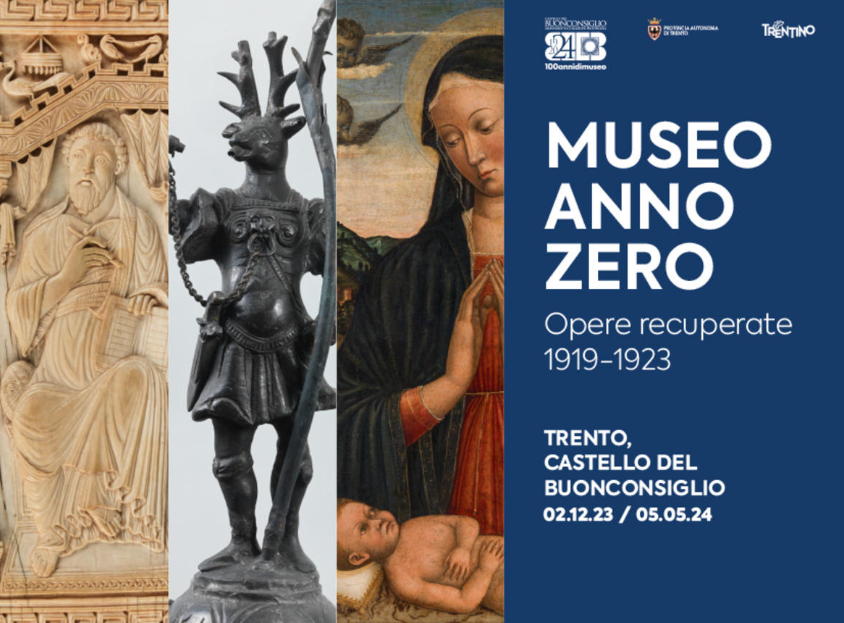Three railway wagons containing the artistic heritage redeemed in the Austrian museums have finally crossed the border... in one of the wagons are the works of art from Trentino that will be exhibited in the National Museum at the Buonconsiglio Castle as soon as possible and can be admired from 2 December to 5 May 2024.
In this few lines of a significant article published by the newspaper "Il Nuovo Trentino" on 31 October 1921, the first success of a long and delicate mission begun at the end of the First World War is announced. But let's take a step back. On 10 September 1919, almost a year after the end of the Great War, the Treaty of Saint Germain was signed, which formalised the transfer of Trentino Alto Adige, after centuries of Habsburg rule, to the Kingdom of Italy. This opens a delicate game relating to the heritage of art and history, both public and private, which was in our territory but which during the nineteenth century and during the years of the conflict had been brought to Austria and the possessions of the empire. The recovery of these cultural assets saw Giuseppe Gerola as one of the great protagonists at the time Superintendent of the Monuments of Romagna and by his will moved to Trento as head of the structure for the protection and conservation of artistic heritage and first director of the Castello del Buonconsiglio museum, officially inaugurated in April 1924. Driven by the desire to regain and recover these testimonies of "Trentino" origin, Gerola, a character that after George Cloney's film could be defined as our "monuments man", began an intense work that ended in 1923 and led to the return to the region of many artistic, bibliographic and archival assets. He brought to the Castello del Buonconsiglio some of the most important pieces of the current collections - the very rare 5th-century Evangeliario on purple parchment, the Sacramentario Udalriciano of 1042, the six 15th-century Trentino Musical Codes a "unicum" in the world, the Fontanella madruzziana in bronze, archaeological finds from numerous locations such as Civezzano and the Doss Trento, dozens of codes and the most important archival documents of the Episcopal Principality now kept in the State Archives of Trento.
This exhibition entitled "Year Zero Museum. Recovered Works 1919-1923"curated by Laura Dal Prà and Claudio Strocchi, intends to present to the public an accurate selection of this varied cultural heritage brought back to its homeland after a long phase of dispersion triggered by precise historical and cultural reasons. Thanks to the opportunity to observe a significant representation of documentary and figurative testimonies in the halls of the Castello del Buonconsiglio, in the same years the subject of a frantic recovery of the building, visitors will be able to discover a little-known chapter of our history and reconsider the past with the correct critical tools. Precisely by virtue of the themes addressed, the exhibition becomes the first ‘approach stage’ to the articulated programming of the initiatives aimed at celebrating the Centenary of the museum in 2024, since an important portion of the material claimed by Giuseppe Gerola then converged permanently in the collections destined for the erecting National Museum – inaugurated on 27 April 1924 –, now known as the current name of Castello del Buonconsiglio. Provincial monuments and collections: a fundamental event for the configuration of the current cultural heritage preserved and enhanced in our territory, which among other things coincides this year with the equally important anniversary of the fiftyyears since the implementation of the transfer of competences of the cultural sector from the State to the Autonomous Province of Trento as a result of the second Statute of Autonomy (1973/1974). The initiative is obviously based on the extensive collection of artifacts that arrived at the Castello del Buonconsiglio the day after their recovery, but it also makes use of the collaboration of the main cultural institutions of the territory with loans from the State Archive, the Historical Museum Foundation, from some parishes in Trentino, as well as the conservation support provided by the Superintendence for Cultural Heritage.
